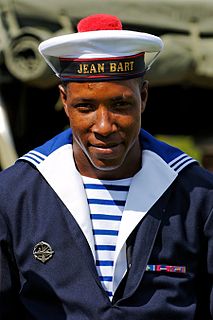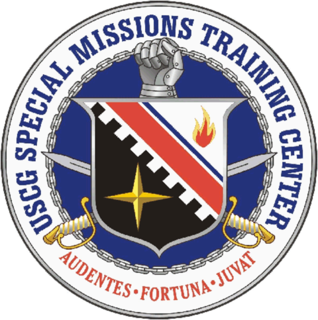
The United States Coast Guard (USCG) is the maritime security, search and rescue, and law enforcement service branch of the United States Armed Forces and one of the country's eight uniformed services. The service is a maritime, military, multi-mission service unique among the U.S. military branches for having a maritime law enforcement mission with jurisdiction in both domestic and international waters and a federal regulatory agency mission as part of its duties. It is the largest and most powerful coast guard in the world, rivaling the capabilities and size of most navies.

Seaman is a military rank used in many navies around the world. It is considered a junior enlisted rank and, depending on the navy, it may be a single rank on its own or a name shared by several similarly junior ranks.

Machinist's mate is a rating in the United States Navy's engineering community.

Radioman (RM) was a rating for United States Navy and United States Coast Guard enlisted personnel, specializing in communications technology.
This article covers the organization of the United States Coast Guard.

People who are in the damage controlman (DC) rating are the Navy's and Coast Guard’s maintenance and emergency repair specialists.

Aviation Survival Technician (AST) is a rating or job specialty in the United States Coast Guard. Rescue swimmer is the collateral duty or aircrew position of the AST. They are trained at the U.S. Coast Guard's enlisted Aviation Survival Technician/Rescue Swimmer school at Coast Guard Aviation Technical Training Center, Coast Guard Air Station Elizabeth City in Elizabeth City, North Carolina.

The United States Coast Guard Yard or just Coast Guard Yard is a United States Coast Guard operated shipyard located on Curtis Bay in northern Anne Arundel County, Maryland, just south of the Baltimore city limits. It is the largest industrial facility in the Department of Homeland Security. It falls under the Coast Guard's Engineering and Logistics Command. It is the Coast Guard's sole shipbuilding and major repair facility, and part of the Coast Guard's core industrial base and fleet support operations. Engineering, logistics, and maintenance responsibilities and complete life-cycle support; installation, operations, maintenance and ultimately replacement. Its annual budget is $88 million.

Fire controlman is a United States Navy occupational rating. Often confused with being fireman onboard a ship, FC's actually operate advanced weapons systems, whereas Damage Controlman (DC) are actually the shipboard firefighters.

Engineman is a United States Navy occupational rating. Engineman was the former name for the current U.S. Coast Guard rating of Machinery Technician.

The Joint Maritime Training Center (JMTC), also known as the Special Missions Training Center (SMTC), is a joint United States Coast Guard, Navy, and Marine Corps training facility located on Camp Lejeune, North Carolina. JMTC's mission is to provide relevant and credible Maritime Security Training and Operational Testing and Evaluation in support of Department of Defense and Department of Homeland Security missions. JMTC comprises four main divisions: Weapons, Port Security, Engineering / Logistics, and Fast Boat.
Radarman was a rating in the U.S. Navy and the U.S. Coast Guard during, and after, World War II. The following ratings existed during the war for male or female enlisted personnel training, or with training, in the operation and maintenance of radar sets:

Charles W. Sexton, Machinery Technician First Class, USCG, was awarded a posthumous award of the Coast Guard Medal for "extraordinary heroism."
A Sector is a shore-based operational unit of the United States Coast Guard. Each Sector is responsible for the execution of all Coast Guard missions within its Area of Responsibility (AOR), with operational support from Coast Guard Cutters and Air Stations. Subordinate commands within a Sector typically include Stations and Aids-to-Navigation (ATON) Teams. Some Sector commands also have subordinate units such as Sector Field Offices and Marine Safety Units that are responsible for mission execution in parts of the Sector's AOR. There are 37 sectors within the Coast Guard.
The Claud A. Jones Award is a prestigious award presented annually to the "Fleet Engineer of the Year" by the American Society of Naval Engineers (ASNE) since 1987. The award recognizes the efforts of United States fleet or field engineers who have made significant contributions to improving operational engineering or material readiness of the United States maritime forces during the past three years prior to nomination.

Marine Science Technician (MST) is an enlisted rate in the United States Coast Guard. They are specialists in enforcing Federal Maritime Laws for Marine Safety, Marine Security, and Environmental Protection.

Daniel Webster Cluff was a United States Coast Guard officer who led one of the U.S. Coast Guard’s largest small-boat rescue operations in the midst of a New England winter storm on February 18 through 19, 1952, as Chatham Lifeboat Station’s officer-in-charge. Warrant Officer Cluff’s expertise in small-boat life-saving operations and confidence in his men's abilities resulted in Coast Guard Motor Lifeboat CG 36500 crew’s rescue of thirty-two survivors from the stern section of SS Pendleton “only minutes before it capsized.”

Richard H. Patterson was a chief petty officer in the United States Coast Guard, decorated for saving the crew of his vessel, USCGC Point Welcome after the skipper and executive officer became casualties during a 1966 friendly fire attack, in Vietnam.














